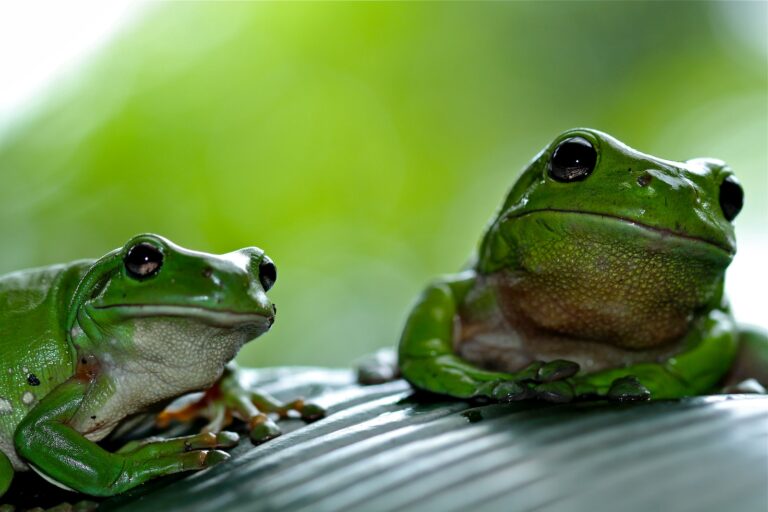Frogs have evolved a dizzying array of mating positions. One example is when a male clambers onto the back of his female. Unlike other mating positions, this one doesn’t involve squeezing!
This position, called cloacal apposition, allows the male to externally fertilize eggs that the female releases into water. It may also help reduce the risk of predators.
Males and Females
Frogs have a dizzying array of strategies for mating, depositing eggs and fertilizing them so that tadpoles can develop into froglets. Some species mate and lay eggs in busy pools of water, while others prefer to do so away from prying eyes. Some even skip the egg stage and give birth to live tadpoles or froglets.
In the wild, frogs begin the mating process by calling for potential partners. A male will croak to attract females, and the pair will then get together in a watery spot for their mating ritual. The male wraps his arms around the female in a position called amplexus, and the female deposits her eggs into the water, which are then fertilized by sperm from the male.
But frogs aren’t the only ones who hear those calls—predatory bats and parasitic flies also pay attention to frog mating sounds. To test how female frogs react to different calls, Halfwerk’s team played recordings of male tungara frog calls in urban and forest locations. They found that females were more likely to respond to calls from forest frogs than from urban frogs.
The frogs’ grasping position may not be as romantic as it seems. Many frogs compete in male-male contests to seize a female in the grasping position—and sometimes end up killing each other in the melee. To prevent this, successful males have thicker forelimbs and enlarged “nuptial pads” to help them grip their mates.
Amplexus
Amplexus is the mating process of Anurans (tail-less amphibians). It involves a male and female anuran clasping each other without penetration. The anuran cloacae, the physical opening from which both male and female anurans release their sperms and eggs, are aligned during amplexus to facilitate fertilization.
During the breeding season, frogs attract females with their specific calls and croaks. The male reaches over the female to initiate amplexus once they are both in fresh water. Some frogs are capable of reproducing multiple times per year, but most reproduce only once. Depending on the species, amplexus can last a few minutes or days, and can take place in a variety of positions.
For example, some frogs breed in terrestrial locations that are far from conventional pools of water. These frogs will seek out tiny pools that are created at the centers of large plants or dig their own mud huts. Male frogs that breed terrestrially tend to have smaller testes than those of their aquatic counterparts and may therefore produce less sperm, so are not as successful at initiating amplexus.
Other frogs may engage in a “glued” type of amplexus, in which the male grasps the female from behind, either around her waist or under/behind her arms. Glued amplexus is named because the male has to use special pads on their front legs to hold onto the slippery female skin. These pads help the frogs grip each other securely in the tight mating position.
Fertilization
For most amphibians, fertilization occurs through external fertilization. A male frog grips the female’s back, pressing his forelegs into her abdomen to anchor himself, and releases sperm over her eggs. Each sperm swims randomly in water until it comes in contact with the eggs, and fertilization is complete. This mating behavior is called amplexus. Some sirenid salamanders and cryptobranchids use internal fertilization, but this is unusual for frogs.
The frog’s egg is very delicate, and it does not have a shell. A layer of jelly holds the eggs together and provides some protection. Frogs lay tens of thousands of eggs in the spring and summer. They hatch into tadpoles in early autumn.
After sperm enters an egg, the cells in the animal half of the embryo start to divide, and a fluid-filled cavity, the blastocoel, forms around the eggs (Figure 2.2A-H). The blastocoel allows cell movements that are required for gastrulation.
When the frog’s egg is locally inseminated, the first cleavage normally occurs well within the animal half of the egg (Elinson, 1975). However, when sperm enters an immature frog egg before it has achieved and arrested at metaphase II of meiosis, chromosomes do not replicate, and development is poor.
This unusual phenomenon, known as polyspermy, is most likely due to the sperm nuclei undergoing some type of non-meiotic activity that does not allow them to replicate DNA.
Reproduction
Frogs have no external genitalia so they use vocalization to attract potential mates. Males call from a waterbody and females move toward the calling male in a process known as amplexus. The frogs then grip each other with their forelimbs, called nuptial pads. The position can vary from a gular or inguinal clasp to loose axillary amplexus. This allows the male to grasp the female around her waist or armpits, which brings their cloacas into closer proximity for fertilization. This position can last for several seconds to months in some species (e.g., Ascaphus truei).
Fertilization takes place either internally or externally. Internally fertilized eggs are not released until the female is ready to deposit them. Typically, this occurs when the water level in a body of water is low and the ponds or lakes have dried up. Then, the female descends from a tree and deposits her eggs in a small area. Some frogs use external fertilization, but most use internal.
When a female deposits her eggs they are usually covered in jelly. The black specks are actually spermatophores, and when they come into contact with water they soak up the liquid and swell into jelly-like structures. Frogs often bury their eggs in damp leaves or under moist soil. They may also lay them in puddles or other small bodies of water such as bogs. Frogs generally reproduce in the spring in temperate climates, during rainy or monsoon seasons in tropical climates, or all year round in the rainforest.
See Also:



